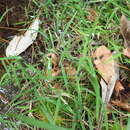mk
имиња во трошки


Leersia virginica, commonly known as whitegrass, white cutgrass, or Virginian cutgrass, is a perennial grass that is native to eastern North America, typically found in partially shaded low-lying wet areas.
Its blooming period occurs from mid-summer to early fall. Whitegrass can be distinguished from rice cutgrass (Leersia oryzoides) by its smoother leaf sheaths, flowering heads with solitary lower branches in the flowering heads, smaller and more strongly overlapping spikelets, and short rhizomes with overlapping scales. Rice cutgrass, in contrast, has leaf sheaths round enough to cause painful scratches, flowering heads with two or more branches at the lowermost nodes, larger and barely overlapping spikelets, and more elongated rhizomes with the scales usually not overlapping.[1]
Leersia virginica, commonly known as whitegrass, white cutgrass, or Virginian cutgrass, is a perennial grass that is native to eastern North America, typically found in partially shaded low-lying wet areas.
Its blooming period occurs from mid-summer to early fall. Whitegrass can be distinguished from rice cutgrass (Leersia oryzoides) by its smoother leaf sheaths, flowering heads with solitary lower branches in the flowering heads, smaller and more strongly overlapping spikelets, and short rhizomes with overlapping scales. Rice cutgrass, in contrast, has leaf sheaths round enough to cause painful scratches, flowering heads with two or more branches at the lowermost nodes, larger and barely overlapping spikelets, and more elongated rhizomes with the scales usually not overlapping.
Leersia virginica est une espèce de plante vivace de la famille des Poaceae. Cette plante à rhizome peut mesurer entre 30 et 100 cm.
Elle est originaire de Virginie mais plus généralement du Sud-Est des États-Unis jusqu'en Floride et du Centre (Missouri).
Leersia virginica là một loài thực vật có hoa trong họ Hòa thảo. Loài này được Willd. mô tả khoa học đầu tiên năm 1797.[1]
Leersia virginica là một loài thực vật có hoa trong họ Hòa thảo. Loài này được Willd. mô tả khoa học đầu tiên năm 1797.